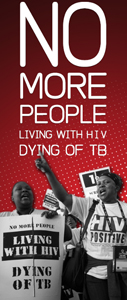 Peaks, progress, impact - three words which reflect the concrete result strong leadership and funding have had on the TB epidemic and also on the HIV epidemic over the last decade. But, as we mark World AIDS Day, the threat posed by TB on people living with HIV remains as significant as ever. Last year, 1.1 million people living with HIV fell ill with TB. TB led to the deaths of 350,000 people with HIV in 2010.
Peaks, progress, impact - three words which reflect the concrete result strong leadership and funding have had on the TB epidemic and also on the HIV epidemic over the last decade. But, as we mark World AIDS Day, the threat posed by TB on people living with HIV remains as significant as ever. Last year, 1.1 million people living with HIV fell ill with TB. TB led to the deaths of 350,000 people with HIV in 2010.
 In early 2012, new TB/HIV policy recommendations will outline how countries can more effectively respond to the co-epidemic through the latest advances in testing, treatment and services. Ensuring the delivery of integrated TB and HIV services to all people living with HIV including women, children and people who use drugs will be critical to stop such deaths. WHO will push countries to fully implement the new policy recommendations so that the target of universal access to life-saving TB/HIV care can reached, and successes of the past year will be further strengthened.
In early 2012, new TB/HIV policy recommendations will outline how countries can more effectively respond to the co-epidemic through the latest advances in testing, treatment and services. Ensuring the delivery of integrated TB and HIV services to all people living with HIV including women, children and people who use drugs will be critical to stop such deaths. WHO will push countries to fully implement the new policy recommendations so that the target of universal access to life-saving TB/HIV care can reached, and successes of the past year will be further strengthened.
Those successes include:
- The number of TB patients who knew their HIV status reached 2.1 million in 2010, equivalent to 34% of notified cases of TB. This was an improvement from 28% in 2009 and almost 10 times better than the 3.7% reported in 2003. The coverage of HIV testing for TB patients was particularly high in the African and European regions, where 59% and 80% of TB patients respectively knew their HIV status.
- The number of HIV-positive TB patients on antiretroviral therapy (ART) has grown steadily reaching over 200 000 last year. Among TB patients known to be living with HIV, 46% were on ART globally (42% in the Africa Region) in 2010. A substantial improvement in ART provision will be needed to reach the target of providing ART to all TB patients known to be living with HIV by 2015 as outlined in the Global Plan to Stop TB. This could be facilitated by using TB services and infrastructure to allow decentralization of care delivery, according to national guidelines and the local context, and will help to avert the unnecessary deaths of people living with HIV from a curable disease.
- TB screening among people living with HIV and provision of isoniazid preventive therapy (IPT) have steadily increased, particularly since 2007. In 2010, 2.3 million were screened for TB (up from 1.7 million in 2009) and 178 000 of those without active TB were enrolled on IPT (double the level achieved in 2009). The number of people living with HIV who were screened for TB was equivalent to more than half of the reported number of people who were enrolled in HIV care worldwide in 2010. The number started on IPT was 24% of the reported number of eligible people living with HIV newly enrolled in HIV care in 2010. Intensified efforts are needed to reach the Global Plan to Stop TB target of providing screening for TB for all those enrolled in HIV care, and providing IPT to all those attending HIV care services who are eligible for it, by 2015.
Dr Mario Raviglione
Director,Stop TB Department
World Health Organization
